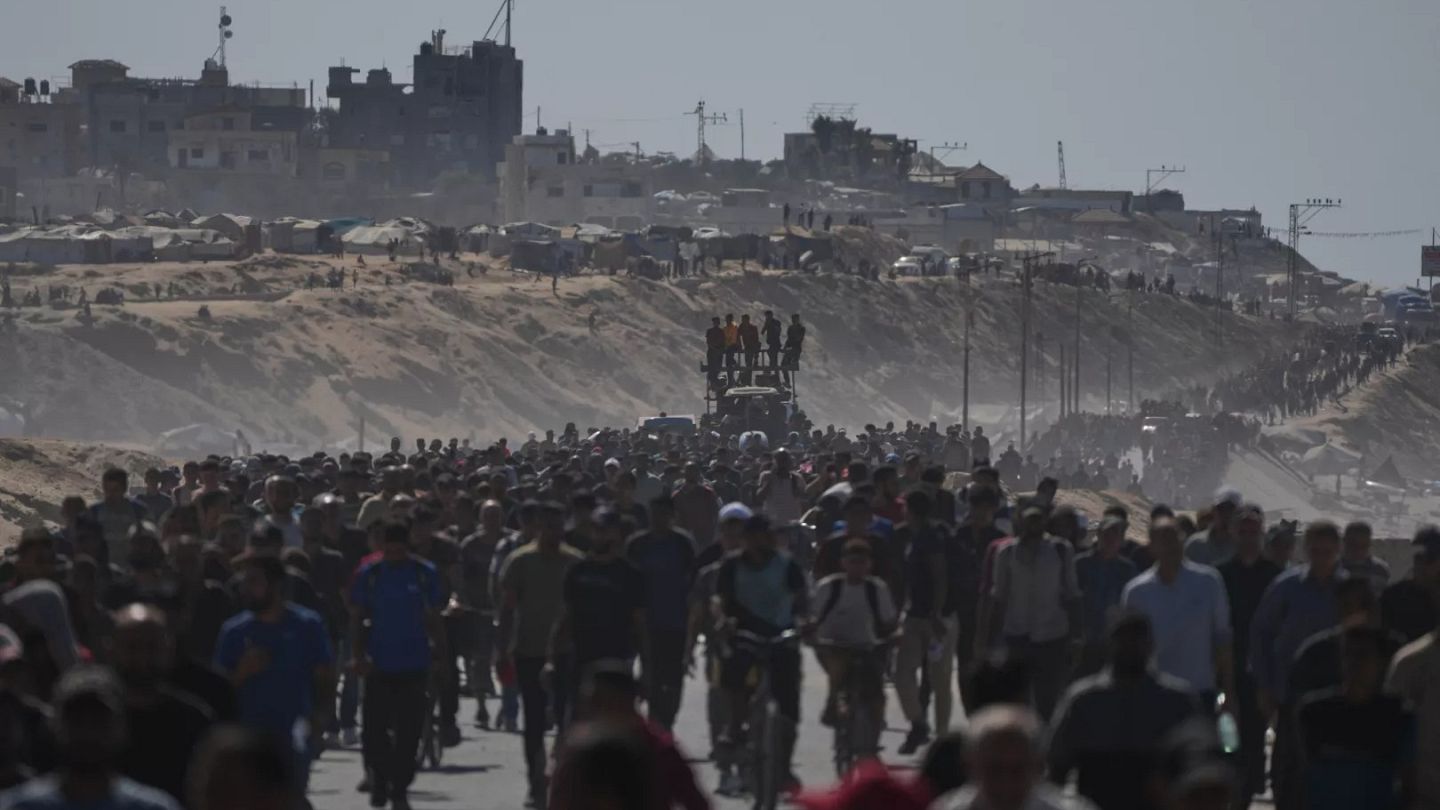Thousands of Palestinians return north as Israel-Hamas ceasefire starts in Gaza
The Israeli military has said it will continue to operate defensively from the roughly 50% of Gaza it still controls after pulling back to agreed-upon lines.
Tens of thousands of Palestinians began heading back to the north of the Gaza Strip on Friday as a US-brokered ceasefire came into effect in a deal that raised hopes for ending the Israel-Hamas war.Questions remain over who will govern Gaza as Israeli troops pulled back and whether Hamas will disarm, as called for in US President Donald Trump's 20-point ceasefire plan.Israel's Prime Minister Benjamin Netanyahu, who unilaterally ended a previous ceasefire in March, hinted that Israel might renew its offensive if Hamas does not surrender its weapons.The latest truce nevertheless marks a key step toward ending a ruinous two-year war that was triggered by the 2023 Hamas-led attack on Israel.The fighting has killed tens of thousands of Palestinians and displaced around 90% of the Gaza population of some 2 million, often multiple times.The military confirmed the start of the ceasefire on Friday morning and the remaining 48 hostages still being held by Hamas are to be released by Monday. Israel believes 20 of them are still alive.Palestinians said heavy shelling in parts of Gaza earlier on Friday had mostly stopped after the military's announcement.Netanyahu said in a televised statement that the next stages would see Hamas disarm and Gaza demilitarised."If this is achieved the easy way — so be it. If not — it will be achieved the hard way," Netanyahu said.He added that Hamas agreed to the deal "only when it felt that the sword was on its neck — and it is still on its neck."The Israeli military has said it will continue to operate defensively from the roughly 50% of Gaza it still controls after pulling back to agreed-upon lines.Meanwhile, the United Nations was given the green light by Israel to begin delivering scaled-up aid into Gaza starting on Sunday, a UN official said. The official spoke on the condition of anonymity to discuss details not yet made public.The aid will include 170,000 metric tonnes that have already been positioned in neighbouring countries such as Jordan and Egypt as humanitarian officials awaited permission from Israeli forces to restart their work.In the last several months, the UN and its humanitarian partners have only been able to deliver 20% of the aid needed in the Gaza Strip, according to UN humanitarian chief Tom Fletcher.People on the moveA steady stream of people, the vast majority on foot, crammed onto a coastal road in the central Gaza Strip, heading north to see what might remain of their homes.The destruction they find this time will be even greater, after Israel waged a new offensive in Gaza City, in the north, in recent weeks. The military bombed high-rises and blew up homes in what it said was an attempt to destroy Hamas' remaining military infrastructure.Palestinians have expressed relief that the war may end, tempered with concern about the future and lingering pain from the staggering death and destruction."There wasn't much joy, but the ceasefire somewhat eased the pain of death and bloodshed and the pain of our loved ones and brothers who suffered in this war," said Jamal Mesbah, who was displaced from the north and plans to return.In Gaza's southern city of Khan Younis, hundreds of Palestinians returning to their homes found wrecked buildings, rubble and destruction after Israeli troops withdrew."There was nothing left. Just a few clothes, pieces of wood and pots," said Fatma Radwan, who was displaced from Khan Younis. People were still trying to retrieve bodies from under the rubble, she added.Many buildings were flattened, and none was undamaged, as people went back to search for their belongings. "We came to a place that is unidentifiable. An unidentifiable town. Destruction is everywhere," said Hani Omran, who was also displaced from Khan Younis.How the agreement is expected to unfoldIsrael is set to release around 2,000 Palestinian prisoners in exchange for the remaining hostages.A list Israel published on Friday did not include high-profile prisoner Marwan Barghouti, the most popular Palestinian leader and a potentially unifying figure.Israel views him and other high-profile prisoners as terrorists and has refused to release them in past exchanges.Khalil al-Hayya, a senior Hamas official and lead negotiator, said on Thursday evening that all women and children held in Israeli jails will be freed.The hostage and prisoner releases are expected to begin on Monday, two Egyptian officials briefed on the talks and a Hamas official said, though another official said they could occur as early as Sunday night.A relative of one of the Israeli hostages believed to have died in captivity says the family is hoping that his body will be returned for burial."It's a measured sense of hope in all hostage families," said Stephen Brisley, whose sister, Lianne Sharabi, and her two teenage daughters were killed in the 7 October 2023 attack."We hold our hope lightly because we've had our hopes dashed before. It still feels like a long way between the announcement of the deal and actually getting Yossi's body back to bury him."As part of the deal, five border crossings are expected to reopen, including the Rafah crossing between Gaza and Egypt, Egyptian and Hamas officials said. That will allow aid to flow into the territory, parts of which are experiencing famine.The Trump plan calls for Israel to maintain an open-ended military presence inside Gaza, along its border with Israel. An international force, comprised largely of troops from Arab and Muslim countries, would be responsible for security inside Gaza.To help support and monitor the ceasefire deal, US officials said they would send about 200 troops to Israel as part of a broader, international team.The US would also lead a massive internationally funded reconstruction effort.The plan envisions an eventual role for the Palestinian Authority, something Netanyahu has long opposed. But it requires the authority, which administers parts of the West Bank, to undergo a sweeping reform programme that could take years.The Trump plan is even more vague about a future Palestinian state, which Netanyahu firmly rejects.


